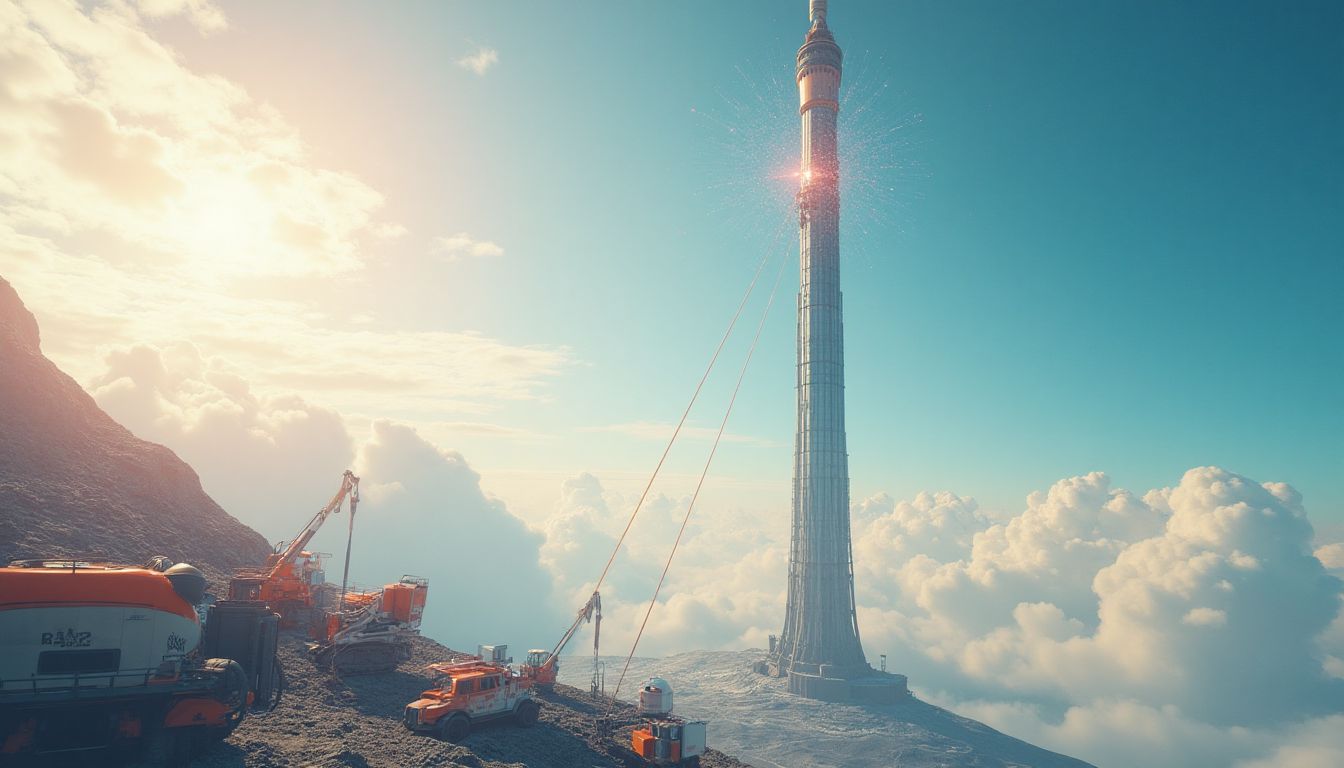Introduction
The measure of intelligence is the ability to change. – Albert Einstein. As we advance further, we realize that our ability to adapt to unprecedented challenges defines our progress. In today's world, this means leveraging cutting-edge technologies like Artificial Intelligence. What if we harnessed AI's power to revolutionize not just our businesses, homes, or cars, but the very way we reach the stars?
Picture a structure, not bound by the traditional constraints of physics as we know it, but reaching beyond our atmosphere—a space elevator. Could this be our next great leap? Isn't it time we shifted our gaze skyward, propelled by AI's endless possibilities? This article explores the grand vision set forth by luminaries like Arthur C. Clarke, who imagined this incredible feat. In the age of AI, can we indeed make these science fiction dreams a reality?
But there's more than just vision needed; there is the nitty-gritty, demanding intricacy, and engineering finesse. Challenges abound in making space elevators feasible, yet, AI could offer innovative solutions, advancing material science, logistics, and safety systems. As we stand poised on the precipice of space exploration, asking the grand question: Will Artificial Intelligence be the key to unlocking the cosmos for everyone?
Artificial Intelligence (AI) refers to the simulation of human intelligence processes by machines, especially computer systems. When applied to the ambitious concept of space elevators, AI can optimize design through generative algorithms, enhance materials through machine learning analysis, and ensure structural safety via predictive analytics, thereby transforming this monumental dream into feasible reality.
Engineering Challenges in Space Elevator Construction
The concept of building a space elevator is akin to attempting to thread a needle from the top of a mountain. It sounds impossible, doesn’t it? But let's break it down. Think of a cable car, except this one reaches into space, anchored down to Earth but stretching deep into the final frontier. The dream is simple, but the pathway is paved with engineering challenges that beg for answers.
First, imagine the material issues. Picture a fishing line trying to hold up a whale. Current materials like steel or carbon fiber, though strong, can't meet the demands of such a colossal construction stretching into the stars. Dare we look into the marvels that material science, with AI's intervention, could unveil?
Structural integrity presents the next conundrum. The cable's journey past the clouds exposes it to an onslaught of atmospheric and space threats—winds, radiation, and pesky micrometeoroids. It's a celestial obstacle course. Ensuring a sturdy structure that can withstand these elements is crucial. It's like preparing a soft shell crab for a boxing match. Challenging, isn’t it?
Then, there's geography to consider. Where on this spinning globe should we plant this high-tech beanstalk? Selecting the right location isn't just about aesthetics. It means accounting for earthquakes, wind patterns, and who knows, maybe even a curious kangaroo.
The energy to power this elevator is not your everyday fender bender either. Solar? Nuclear? Perhaps a blend of what's not yet invented? Engineers need a reliable, sustainable energy source potent enough to lift payloads to the heavens. The task is herculean, yet ripe for AI's ingenious solutions.
And safety, well, everyone's favored dilemma. Emergencies and technical failures need agile, responsive systems in place. AI promises real-time monitoring and smart systems but isn't it like trusting a toddler with your favorite antique vase? Robust redundancy and safety mechanisms are our best bet.
In essence, while these challenges seem insurmountable, they are only stepping stones in the world of modern engineering and AI innovation. The journey to the stars starts with addressing these hurdles head-on, and letting Artificial Intelligence lend us a cosmic helping hand.
The Potential of Material Science Innovations
Advancements in material science present opportunities to develop materials specifically suited for space elevator construction. In the world of space elevators, the mantra isn't quite 'heavier is better.' Here, we worship at the altar of strength-to-weight ratios. Enter, the mighty innovations!
Graphene and Carbon Nanotubes: The Superheroes of Materials
Step aside Superman; your cape just got competition. Graphene and carbon nanotubes have tensile strength so mind-bogglingly high and weight so light that they seem straight out of a comic book. This makes them prime candidates for crafting the cable that will support the space elevator.
Advances in Composite Materials: Getting Stronger and Cheaper
In the realm of composites, it's like we're at a perpetual "buy one, get strength free" sale. Recent breakthroughs mean making materials that are not only stronger and lighter than those of yore, but they can also be produced at a price that wouldn't make investors weep into their coffee.
Synthetic Biology and Genetic Engineering: Nature Meets Innovation
Why fight nature when you can have a chat? Enter Synthetic Biology and genetic engineering. Imagine creating cables using bioengineered processes. It could be the Michelin-star chef approach to building—start with top ingredients, and everything else will fall into place like a perfect souffle.
Self-Healing Materials: The Gift That Keeps on Giving
The last thing you want on your celestial journey is a cosmic boo-boo. Self-healing materials come to the rescue, like having a NASA-approved band-aid for your materials. This tech can enhance the lifespan and reliability of the space elevator, keeping things running smoother than a jazz saxophone solo.
Corrosion Resistance and Longevity: Guarding Against Mother Nature's Tantrums
Remember the pain of a rusty bike chain? Now, multiply that annoyance by a billion and you have a corroded space elevator. Weather in space is unforgiving, so creating materials with corrosion resistance is central to making anything that lasts longer than a celebrity marriage.
Robotics and Automation in Construction
Picture this: an army of robots taking the lead in constructing our dream of a space elevator. This isn't science fiction anymore; it’s like a futuristic construction site with a hint of "The Jetsons."
Autonomous Drones and Machines: Buzzing Bees of the Space Race
Utilizing drones for surveying and transporting materials can streamline the space elevator construction process. You might say they're the busy bees of this engineering hive, flitting around and making sure everything fits just right.
Remote-Controlled Construction Techniques: The Smart Orange Cones
Picture construction workers—only these workers are miles away, sitting in Star Trek-style chairs while their robotic minions toil away. By employing robotics controlled remotely, we're ensuring safety while actively living out our sci-fi dreams.
Collaborative Robots (Cobots): Teamwork Makes the Dream Work
In the battle of humans vs. robots, why choose sides? Collaborative robots, or 'cobots,' let developers have their cake and eat it too. By working together, they create a construction site more efficient and safe than grandma's holiday baking team.
Modular Construction Approaches: Giant Lego Blocks
Who didn’t love playing with Legos as a kid? The sandcastles of our past now translate to the modular construction approaches of our future. Prefabricated modular components can slash construction time and cost because assembling (rather than building) is the new black.
Real-time Monitoring and Adaptation: Keeping Pace with Usain Bolt
With AI-driven autonomous systems, real-time monitoring and adaptation ensure that like a tortoise catching up to Usain Bolt, no opportunity to enhance construction protocols is missed. Smart decisions are made faster than you can say "speed of light."
AI-Driven Design and Simulation
The role of Artificial Intelligence in the design and simulation of space elevators represents a groundbreaking shift in how we approach complex engineering projects. By integrating AI into the intricate process of design, we leverage computational power to change a concept from theoretical to practical. This change ensures efficiency, precision, and adaptability. The design and simulation stages are where AI reveals its true potential, revolutionizing approaches with cutting-edge techniques.
Generative Design Algorithms
AI's ability to generate unlimited design permutations is changing the game. Generative design algorithms allow AI to explore design solutions within the constraints set by engineers. Aesthetic beauty, structural integrity, cost-effectiveness; AI covers it all. Think of it as an artist with the logic of an engineer. This leads to innovative designs that human minds may never conceive. In this way, AI offers boundless possibilities while ensuring each design keeps functionality at its core.
AI doesn't merely assist; it becomes a co-creator. It's a partner always ready to explore 'what if' scenarios. Such algorithms have created designs for numerous industries, including automotive and consumer products. The Autodesk Generative Design platform is an industry leader in these innovative automations, and space elevator design could be its next frontier.
Predictive Analytics for Structural Performance
Predictive analytics assesses risks and predicts potential challenges. This makes AI invaluable in space elevator construction. These predictions ensure the structural integrity of the elevator by anticipating performance under various conditions.
- Environmental Impact Assessment: AI can simulate different weather scenarios and predict how the design will hold up.
- Risk Analysis: Identifying weaknesses before construction minimizes costly adjustments and enhances safety.
Compare it to having an oracular insight into the future of your design project. Organizing predictive analytics minimizes costly errors and maximizes readiness.
Virtual Reality and Augmented Reality Tools
Integrating VR and AR into design allows teams to walk through and interact with a digital twin of the space elevator. Imagine experiencing the project before breaking ground. Engineers, stakeholders, and even public audiences can visualize the final product and understand its implications.
VR and AR provide a middle ground where digital overlays meet the real world. It's akin to trying on clothes before you buy them. Advantages include:
- Interactive Design Review: Enhances stakeholder understanding and approval during project pitches.
- Proactive Troubleshooting: Identifies and resolves gaps before they manifest in reality.
Multi-Physics Simulation
The space elevator exists where atmospheric and cosmic forces intersect. That's why multi-physics simulations are crucial. These simulations assess how a structure will behave under combined physical disciplines, such as thermodynamics, electromagnetism, and fluid dynamics.
By simulating these complex interactions, engineers gain a comprehensive understanding of potential issues. A space elevator designed for reality's numerous challenges offers greater confidence and feasibility in its implementation.
Decision Support Systems for Project Management
Effective project management harnesses data for insightful decision-making. AI-powered decision support systems help organize time, resources, and manpower. Whether it’s a sudden weather delay or resource misalignment, informed decisions ensure smooth progress. Key components include:
- Data-Driven Scheduling: Streamlines timelines and resource allocation.
- Risk Identification: Alerts project managers to potential bottlenecks.
- Efficient Resource Allocation: Ai provides assistance with material sacks, transportation, and logistics planning.
Combined, these systems pave the path for a seamless and cohesive development process of grand projects like space elevators.
Economic and Political Factors Influencing Space Elevator Development
The journey of creating a space elevator is not purely scientific but deeply entwined with economic and political considerations. This socio-political dimension turns the engineering feat into a global collaboration. If AI is the brain behind the operation, then economic and political considerations form its beating heart, dictating both pace and scope.
Funding and Investment Challenges
Constructing a space elevator demands vast investments, dwarfing most infrastructure projects. However, the prospect of slashing transportation costs to a fraction of present levels means significant long-term savings. Moreover, successful project implementation could promise unparalleled rewards in space access and exploration.
- Initial and Ongoing Investments: An endeavor requiring sustained financial commitment over decades.
- Public and Private Sector Funding: Strategies needed to coax investments from diverse financial circles.
Organizations like NASA and SpaceX might serve as potential allies, driven by an eagerness to reduce space exploration costs.
International Collaboration and Regulation
Since space is shared above us, elevating mankind's reach requires comprehensive global cooperation. Assimilating different cultures, technologies, and strategies defines the complexity of this endeavor. Complex international laws seek enforcement while diverse regulations for space treaties germinate.
It's an epic diplomatic ballet encompassing:
- Cross-Border Regulation: Uniting global stances on security, environment, and space tabs.
- Technology-License Sharing: Nations synchronizing innovations for mutual benefits.
The success of space elevator initiatives hinges on these diplomatic negotiations, where science meets statecraft.
Public Perception and Acceptance
With large-scale initiatives like these, public buy-in is vital. Why should taxpayers invest in celestial towers? What are the immediate benefits compared to existing benefits of scarce resources? The success of these projects hinges upon successfully communicating long-term goals such as those presented by initiatives like Blue Origin.
Shaping perception includes:
- Educational Outreach: School and public forums increase awareness about the benefits.
- Public Demonstrations: Hosting interactive simulations or outreach programs to pique enthusiasm.
Resource Scarcity and Allocation
The construction feasibility of a space elevator is directly connected to resource management. Essential resources for research, development, and manufacturing should be channelized, and scarcity addressed.
- R&D Resource Allocation: Prioritizing funds and efforts toward core technological challenges.
- Material Sourcing: Collaborating with industries with a pipeline for carbon structures like graphene and carbon nanotubes.
A delicate balance between demand and supply ensures equitable inbound requests for essential materials.
The Role of Private Enterprises vs. Government Initiatives
This duality of purpose raises critical questions on who steers the proverbial ship. Do governments collaborate directly with private corporations, or do we expect public enterprises to maintain majority stakes?
Considerable players include:
- Private Innovations in Technology: Adopting initiatives that maximize corporate creativity and flexibility—potentially spearheaded by industry leaders like Tesla.
- Government Policy Integration: Overseeing regulatory and policy alignment with larger economic goals.
This seesaw of authority, with potential power struggles, will influence the design and overall success of space elevators.
AI-Powered Solutions: Bridging Engineering and Innovation
Artificial Intelligence could address the multitude of engineering challenges surrounding space elevator construction through targeted technological strategies and innovations. Picture a world where challenges are met with the exact precision of AI's judgment, ushering us into an era of celestial access.
To tackle material limitations, AI could analyze molecular properties of new materials, pinpointing candidates ripe for development. Imagine machine learning algorithms speeding up the process of testing and manufacturing potential materials, optimizing their properties remotely—an avant-garde approach to material science.
For structural integrity, AI-driven simulations could predict performance outcomes under diverse environmental conditions from wind to cosmic radiation, allowing engineers to make proactive, informed decisions. This predictive analytics capability could reinforce materials based on data analysis, igniting unprecedented innovations.
AI can enable logistical efficiencies through smart algorithms managing supply chains, optimizing for cost, time, and resource allocation, transforming how we approach construction. Picture automating contractors' daily operations with AI tools—labor managed with the efficiency of a well-oiled machine.
Safety systems could be enhanced through AI-driven real-time monitoring systems. Drones equipped with sensors could provide a constant surveillance program, issuing alerts for any structural anomalies or predicted mechanical failures. Each moment becomes enhanced by a vigilant AI, a defender of human cargo.
Ultimately, integrating AI into every phase of development does not just accelerate progress; it elevates the safety and viability of the space elevator project, turning what once was an ambitious dream into a structured pathway toward reality.
Actions Schedule/Roadmap (Day 1 to Year 2)
Day 1: Assemble a multidisciplinary team of experts in aerospace engineering, material science, AI technology, robotics, environmental science, and project management. This team could include representatives from organizations like the NASA and Jet Propulsion Laboratory to provide insights and expertise.
Day 2: Conduct a comprehensive feasibility study evaluating design, cost, environmental impacts, and societal benefits. Involve public consultations for transparent communication.
Day 3: Identify potential collaboration opportunities with universities, such as the Massachusetts Institute of Technology (MIT) and Stanford University, seeking partnerships for research and development.
Week 1: Establish partnerships with private companies, including SpaceX and Blue Origin, to gain insights and technology support for the project.
Week 2: Allocate budgets for material research projects, AI software, and robotic systems. Hire financial consultants to model funding strategies.
Week 3: Begin intensive research on novel materials, focusing on graphene and carbon nanotubes, bringing in expert material scientists to lead the effort.
Month 1: Conduct initial designs using AI-driven software for generative design, factoring in various engineering constraints, simulating potential outcomes.
Month 2: Initiate robotic system development for construction and monitoring, integrating AI to facilitate communication between humans and machinery.
Month 3: Commence extensive material testing and simulations using AI tools. Use virtual testing facilities to simulate stress scenarios and failure tests.
Year 1: Finalize design, proceed with community outreach for public support, and initiate funding campaigns to gather interest and resources.
Year 1.5: Build small-scale prototypes to test production methods and material effectiveness, engaging early-stage investors eager to be part of this revolutionary initiative.
Year 2: Begin scaling up for actual construction based on findings and community feedback. Keep the public informed of progress, celebrating milestones to maintain enthusiasm and public interest.
Conclusion: The Pathway to the Stars
The journey toward constructing a space elevator is fraught with challenges yet filled with possibilities. By leveraging artificial intelligence, humanity stands on the brink of unlocking the cosmos. As we have examined, the engineering challenges—from materials to safety systems—can be tackled with innovative AI solutions. The dream of a space elevator could well become humanity's most monumental achievement, paving the way for interstellar exploration and making access to the stars a tangible reality.
Let’s not forget that the magic lies within the pursuit itself. As we converge innovation with aspiration, we beckon the cosmos closer than ever. The spark of imagination drives us to create a better future where the sky is not the limit, but merely the beginning. How will you contribute to this magnificent leap into the unknown?
FAQ
Q: What is a space elevator?
A: A space elevator is a proposed transportation system that would allow for lifting cargo and humans from the Earth’s surface to space. It works by using a long cable anchored to the Earth's surface that extends up into space towards a counterweight that is in orbit. Imagine a very tall building reaching all the way to space!
Q: Why are space elevators important?
A: Space elevators could change everything about getting to space! Right now, sending stuff into space is very expensive. A space elevator could make it much cheaper and easier to transport materials, making space exploration and even trips to other planets more accessible for everyone.
Q: What role does AI play in building space elevators?
A: Artificial Intelligence, or AI, can help in many ways. It can analyze materials to find the best options, help design the elevator, manage construction, and even ensure safety during operations. Imagine having a super-smart assistant making sure everything works perfectly!
Q: What materials are being considered for space elevators?
A: Researchers are looking at exciting materials like graphene and carbon nanotubes because they are extremely strong and lightweight. These materials are better suited for handling the immense tension and challenges of space travel.
Q: When might we see a space elevator constructed?
A: While there is no exact timeline, experts say that if we keep making progress with technology and materials science, we could see real prototypes being built in the coming decades. What a cool thought, right?
Q: What are the main challenges of building a space elevator?
- Material Limitations: Finding materials that can handle the extreme conditions in space.
- Structural Integrity: Ensuring the elevator can withstand winds and possible space debris.
- Safety Systems: Creating systems that keep passengers safe during their journey.
- Location and Geology: Choosing the best place for the base without risks like earthquakes.
- Energy Supply: Figuring out how to power the elevator sustainably.
Q: Who is working on the concept of space elevators?
A: Many scientists and engineers from different places are interested in space elevators. Some universities involved in this research include MIT and Stanford. Companies like SpaceX and Blue Origin are also looking at new ways to make space travel easier.
Q: Will a space elevator only be for cargo, or could people use it too?
A: Both! The idea is that a space elevator could carry people and cargo. Someday, you might be able to take a smooth ride up to space just like in a regular elevator, but a lot taller! It could open up a whole new world of adventure beyond our planet.
Q: How safe would it be to travel on a space elevator?
A: Safety is a top priority in engineering. The technology behind space elevators would include many safety systems and backup plans to handle emergencies. With AI and robotics monitoring everything, the goal is to make traveling to space as safe as getting on an airplane.
Wait! There's more...check out our gripping short story that continues the journey: Elara's Choice
Disclaimer: This article may contain affiliate links. If you click on these links and make a purchase, we may receive a commission at no additional cost to you. Our recommendations and reviews are always independent and objective, aiming to provide you with the best information and resources.
Get Exclusive Stories, Photos, Art & Offers - Subscribe Today!





























1 comment